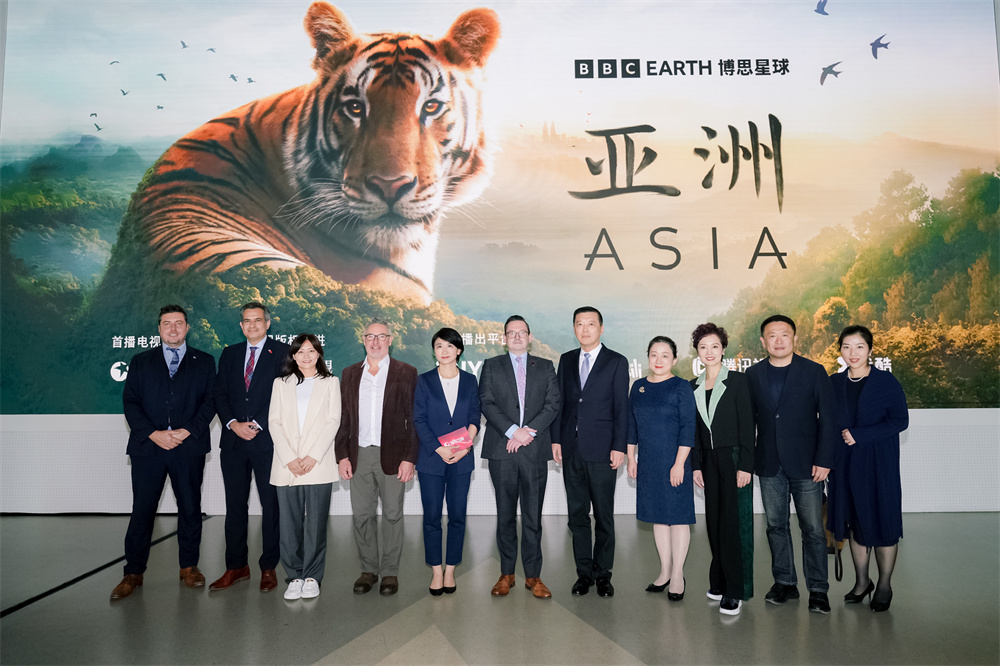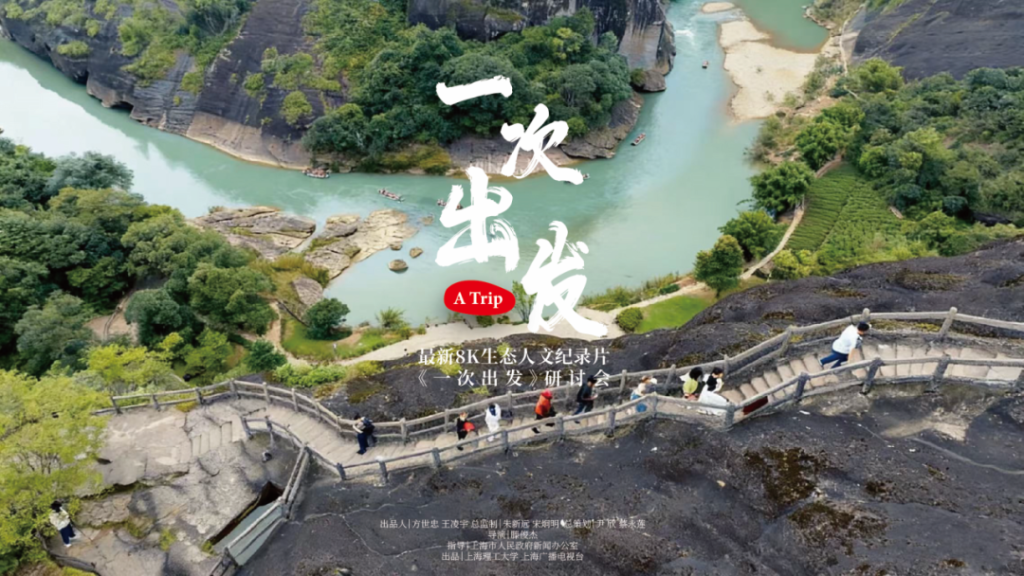
On November 4, the premiere of BBC Earth’s annual grand production, Asia, took place at the Shanghai Film Museum. The new documentary Asia is produced by BBC Studios' Natural History Unit, with narration by Sir David Attenborough, and the launch ceremony was held on October 25 during the Shanghai-London Film Industry Dialogue in London.

Premiere event
The documentary has been brought in by Phoenix TV and will premiere on November 5 at 10 PM on SMG’s Dragon TV, with simultaneous streaming on iQIYI, Bilibili, Tencent Video, and Youku.
As the first wildlife documentary by BBC to focus on the Asian continent, Asia took nearly four years to shoot. It explores the breathtaking beauty and survival stories of wildlife across this miraculous continent, presenting stunning landscapes and capturing a series of previously unseen animal behaviors using cutting-edge filming techniques.
During the event, Yin Xin, Deputy Director and Deputy Chief Editor of Shanghai Radio and Television Station, exchanged a cooperation agreement with Jonnie Irwin, head of BBC Studios’ Natural History Unit. The three-year collaboration will include three new headliner documentaries produced by BBC Studios’ Natural History Unit: Blue Planet III, focusing on the deep-sea animal world; Hidden Planet, showcasing the microscopic world of insects; and Kingdom, which focuses on Africa’s animal families. These documentaries will air on Dragon TV under Shanghai Radio and Television Station. Yin stated that SMG is constantly exploring new international cooperation content and models, and has significantly increased the documentary segment on Dragon TV, aiming to comprehensively promote global and Chinese civilization through documentaries.

Asia still
The premiere also featured an advance screening of the first episode, Under the Waves. After the screening, Jonnie Irwin shared exciting behind-the-scenes stories with the attendees. Irwin expressed, “Asia is incredibly diverse; it is a microcosm of the entire world. From the vast Gobi Desert to the rainforests of Borneo, from the polar wastelands of Siberia to the coral reefs of the Indian Ocean, Asia will take viewers deep into the rugged lands of this continent, showcasing the vibrant world of wildlife. Through this film, we hope viewers will gain a new understanding of Asia and see this unparalleled place from a different perspective.”
From the original Planet Earth series to Wild China, co-produced by BBC Studios and CCTV, Jonnie Irwin has visited many places in China and Asia over the decades. He shared his deep love for Asia, stating, “There are always new discoveries, and the people here are very friendly.”

Asia still
[Dialogue]
Pioneer News: What new perspectives does Asia offer that are different from past documentaries?
Jonnie Irwin: What we showcased at the screening were all new stories, new species, new locations, and new behaviors. We utilized new technologies, including drones, which provided us with entirely new perspectives; for instance, we showcased footage of the Bengal tiger, which would have been impossible to capture five years ago.
In fact, my first visit to Asia was over 30 years ago. However, some of the animal species appearing in Asia were ones I hadn’t even known existed, despite having specifically studied wildlife for over 40 years and holding a PhD in the field. There are still many intriguing animals to discover in Asia.
For example, in the first episode, we see the sea hare or the ribbonfish, animals I had never seen or heard of before. Additionally, while filming in the desert interior, we captured footage of the Gobi bear in Mongolia. I had heard of this animal, but I never imagined we could film it. We documented the story of a mother bear and her cub; currently, only about 40 Gobi bears remain. Furthermore, we found a forest near the Iraq-Iran border where we filmed leopards. I had no idea there were wild animals in that area, as it has been a conflict zone for a long time.
In the second episode, Above the Clouds, there is a segment about cave-dwelling birds called “swifts.” I had limited knowledge of these animals and didn’t realize there was a freshwater pond in the same cave where fish catch birds. If a bird flies close to the pond, the fish will leap out to catch it, which I found fascinating.

Asia still
Pioneer News: Snow leopards have received a lot of international attention in recent years, and many have filmed them, including their hunting and nurturing of cubs. Did Asia capture any notable aspects of the snow leopard?
Jonnie Irwin: Yes, we did capture snow leopards. While discussing the mountainous environment in India, we filmed their courtship behaviors, where two male snow leopards fought over a mate. As mentioned in the documentary, the male would follow the female for weeks because she was very cautious, ultimately earning her trust.
Pioneer News: What do you think is the reason we see more footage of snow leopards now: environmental issues or human factors?
Jonnie Irwin: Twenty years ago, I found it very difficult to film snow leopards. Now, there are more people looking for snow leopards, more people with good cameras, and once everyone learned more about snow leopards, they began sharing information with each other, such as where to find them and how to film them. In Planet Earth III, we also filmed snow leopards in Mongolia, and various scientists have been studying them. There's also been footage of snow leopards in series about China. I believe all factors have contributed to the increased visibility of snow leopards on screen.

Asia still
Pioneer News: Asia features animals that are very familiar to Chinese audiences, such as tigers and pandas. How do you present new stories about these well-known animals?
Jonnie Irwin: We hope to capture tigers from new angles. In the segments, we’ve filmed some of their new behaviors using drones, or we searched for tigers in unusual locations. One episode features tigers filmed in an urban environment in India. While tigers are well-known animals, it is incredible to discover them in an unexpected place. This is what we mean by capturing unusual behaviors of familiar animals.
Regarding the segments on giant pandas, although they are familiar animals, we tell a heartwarming and touching story between a mother and her cub. Thus, I believe the key is whether we can touch the audience’s emotions and tell a compelling story. No matter what story is told, I look for three elements: first, is it a fresh and novel story? Second, can it create emotional resonance? Third, is there some technical innovation or a new way to narrate this story?

Asia still
Additionally, there is an episode in Asia titled Crowded Continent, which tells the story of wild animals living in the world’s largest and most densely populated cities. Many of the top ten most populated cities in the world are located in Asia, and we will observe how animals coexist with humans in urban settings. For example, in Japan, we filmed deer living among humans. There is also an episode called Saving Asia, focusing on heroes and ordinary people dedicated to nature conservation in Asia and how they are saving the continent.
Pioneer News: You mentioned emotional resonance and discussed wildlife survival in war zones. How do we express emotions related to animals in conflict zones?
Jonnie Irwin: This story takes place in a place called Kurdistan, on the border of Iran and Iraq, which has long been a conflict area. We heard about a rare leopard called the Persian leopard found there, so our filming team collaborated with local scientists. Without spoiling too much, in this story, you will see a female Persian leopard with her cubs. The challenge was that filming the animals required crossing a minefield. We were extremely cautious. I think the presence of the minefield may have protected the wildlife. Emotionally, this story surprises viewers, as encountering such a rare animal is astounding; the journey of a mother Persian leopard raising her cub is incredibly touching. We hope to evoke feelings of emotion, astonishment, and warmth in viewers.
Pioneer News: I can't wait to see this story.
Jonnie Irwin: This segment is not particularly long. We’ve also captured sharks off the coast of Israel. I’ve seen sharks before, but I didn’t expect to find sharks outside a power station in Israel. The temperature of the water released by the local nuclear power plant is quite high, which helps the sharks survive while giving birth, so I think our team is very adept at finding interesting stories.
Pioneer News: Will the team follow this approach to finish filming the remaining continents?
Jonnie Irwin: We won't follow a strict logic of filming each continent, but we will collaborate with other partners and platforms to focus on documentaries about different continents. For instance, we are working with Disney on a documentary called Home, and we will also be capturing content about Africa, Asia, and South America, all targeting different audience groups. The filming perspectives will differ from those used in Asia since there are millions of species on Earth, and there are countless stories yet to tell.

Asia still


